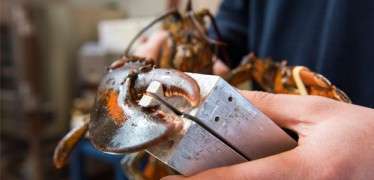Noninvasive procedure to determine the viability of lobsters for shipping

Developing a noninvasive procedure to determine the viability of lobsters for shipping was the goal of a recent cross-discipline research project led by a University of Maine undergraduate student.
Matthew Hodgkin, a fourth-year animal and veterinary sciences major from Colebrook, Connecticut, developed a method to evaluate lobster livelihood based on claw strength while working with Bob Bayer, executive director of the Lobster Institute at UMaine; Michael "Mick" Peterson, a mechanical engineering professor, and Thomas McKay, a fourth-year mechanical engineering technology student.
The inspiration for Hodgkin's research came from his adviser Bayer who had approached Peterson two years ago as a result of a press inquiry about the strength of lobster claws. Peterson and McKay then built a device to measure the closing strength of a lobster's crusher claw, Hodgkin says.
Hodgkin has since worked with Bayer to determine if the device could be used to predict the viability of lobsters for shipping. Knowing a lobster's viability is relevant to Maine's primary seafood industry because it can determine if the crustacean is most suitable for shipping live or going straight to a processing plant, according to Hodgkin.
"This research would save the distributors money from losses incurred during shipment. If the most healthy and viable lobsters were picked to ship there would be less casualties due to weakness," he says.
The device is an alternative to the commonly used invasive procedure that calls for measuring serum protein content in lobster blood. Shipping facilities use handheld refractometers to measure the protein once lobster blood is extracted by a syringe, according to Hodgkin.
The serum protein measurement reflects the amount of muscle mass a lobster has. Lobsters with less muscle mass would not be able to handle the stress of shipping, Hodgkin says.
The technique was developed in the 1980s by Bayer and graduate student Dale Leavitt.
The new device allows for muscle mass measurements to be determined by claw strength as opposed to using a blood sample. The prototype contains an aluminum load cell located at the point where the most pressure is exerted by the lobster when it closes its claw.
"In our first trial the gripper was made from plastic, and that did not last long with the lobsters," Hodgkin says.
Once the rectangular gripper is placed in the lobster's grasp, the load cell measures the pressure in pounds per square inch. The measurements then appear on an attached electronic reader that looks similar to a digital alarm clock.
Hodgkin examined various lobsters of the same size from different stages of the molt cycle. He tested the lobsters for crusher claw strength using the load cell meter and used a refractometer to evaluate serum protein in the blood. When comparing the methods, he found the closing strength of a crusher claw correlates with serum protein.
The prototype has been field tested at local lobster dealers and seems to work well, Hodgkin says. He adds more testing is needed to study the effects of water temperature on the ability of the lobster to show interest and on its strength.
Provided by University of Maine



















